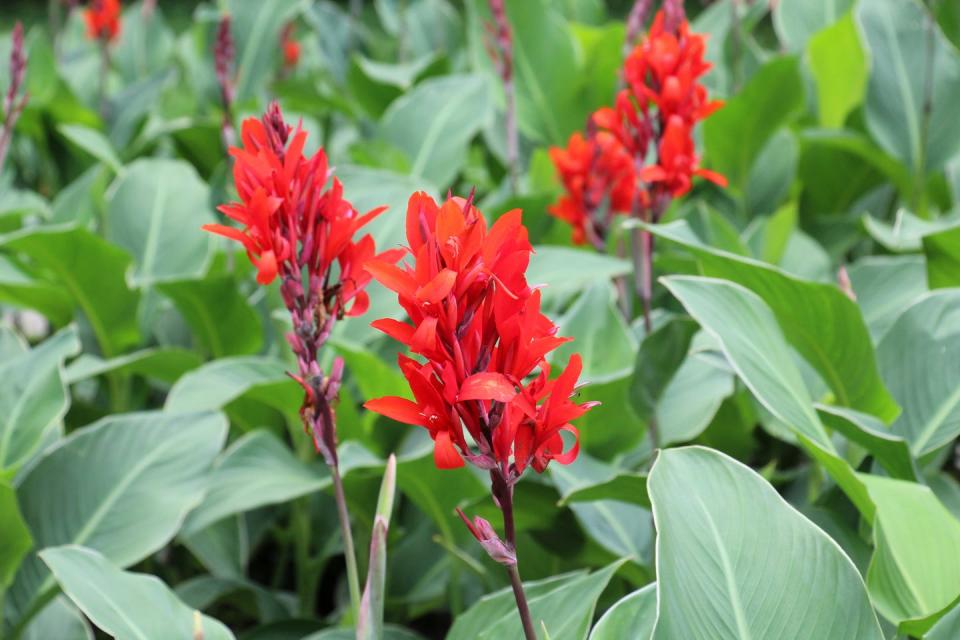10 garden jobs to tick off this October
October is a month of rich harvests and warm suppers. Families carve hollowed faces on homegrown pumpkins for a ghoulish night of celebration. Conkers are gathered, and cosy jumpers and scarves make their autumn debut, as we feel the pinch of falling temperatures.
So, keep warm this month with 10 jobs you can be doing that will help get your garden ready for winter...
Plants

1. Cannas
Cannas are not made for the cold, so give them winter protection by placing them in a shed or greenhouse. Carefully dig up the plants, cut away dead flowers and foliage, to help prevent rot, and plant cannas in pots using old compost.
If cannas having been growing in pots throughout summer, simply gather the potted plants together and store in the greenhouse or shed. You also might want to wrap them in horticultural fleece for further protection.
2. Dahlias
Protect your dahlia stock from the rigours of winter by using a garden fork, or hand trowel, to carefully dig them up from beds, borders and pots. Cut foliage back to a couple of cms above the tuber, turn upside down and let it drain for a few days. Once dried, place in a cardboard box, and store somewhere cool, dark and frost free. It’s a good idea to label the tubers, so there’s no confusion when planting up different varieties next spring.
3. Sow
Sow hardy annuals now for next year’s displays. Flowers, such as cosmos and marigolds, can either be sown directly into the soil or into seed trays using seed compost. Water trays carefully, and place in a warm greenhouse. Sweet peas can be sown into pots, watered and left to germinate in a greenhouse or cloche where they will happily sit until spring.
Vegetables
4. Garlic
Garlic requires a cold period to help develop its cloves, so plant now for a successful crop next summer. Don’t be tempted to purchase bulbs from supermarkets as they can harbour disease. Instead, buy bulbs from a garden centre or online supplier.
The individual cloves should be planted 20cms apart, in rows 30cms apart, in well-drained, fertile soil, with the tips 2cm below the soil surface. Cover over planting area with horticultural fleece, or netting, to prevent birds from pulling up the cloves.
5. Cucurbita
Squashes and pumpkins should be harvested this month. To know when they are ready, the vine attached to the squash should be withered and cracked. Cut away from the plant, leaving several cms of vine still attached to the vegetable. Then, place outside, somewhere sheltered and dry, for a week or so to cure. Once cured, pumpkins and squashes can be stored for up to several months.
Fruit
6. Rhubarb
Now’s the time to lift and divide rhubarb crowns. Using a sharp spade, split the crown, ensuring each section contains at least one growing point. Re-plant in well-drained, fertile soil, keeping each segment well-spaced. Water in well and apply a thick mulch around the planted crowns.
Greenhouse
7. Insulate
Many gardeners will keep their greenhouses heated over the winter months, allowing them to continue sowing and growing. However, with spiralling energy costs, an electric heater may no longer be an option. Therefore, consider insulating your greenhouse with bubble wrap. It retains warmth, cheap to buy and doesn’t reduce light levels. Also, try to keep greenhouse doors and vents closed, and ensure any damaged panels are quickly repaired.
8. Winter lettuce
Don’t be quick to dispose of used tomato growbags lying in your greenhouse. By cutting open the bags, and exposing the compost, try growing winter salad. Simply create shallow troughs, sow seed sparingly, then cover over lightly with compost and water. Varieties, such as lamb’s lettuce and miner’s lettuce are ideal to grow throughout winter.
Maintenance
9. Leaf mould
As the leaves begin to fall, try collecting and storing them in an empty compost bay or wired pen. Give them a year or so to decompose, and twelve months from now you will have gained a rich supply of leaf mould.
This is ideal for your flower beds as a top dressing or mulch. If you’re lacking storage, use bin liners as they can be filled with leaves and tucked away into small spaces. Ensure you pierce the bags several times to allow airflow, and prevent your leaves from becoming a foul-smelling slush.
10. Soil
If you’re leaving vegetable beds empty over winter, turn the soil. This will not only aerate the soil, but will expose hiding pests. Apply a thick layer of well-rotted manure, or compost, to the surface. The worms and weather will help break it down over the winter months, enriching the beds with valuable nutrients and improving soil structure.
You Might Also Like


